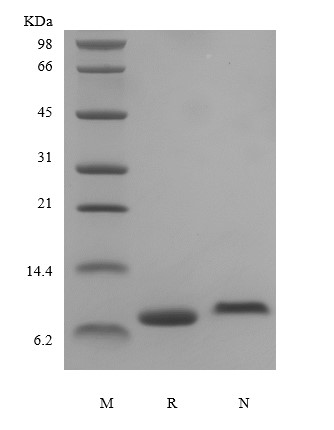- Synonyms
- LR3 IGF-I
- Source
- Escherichia coli.
- Molecular Weight
- Approximately 9.1 kDa, a single non-glycosylated polypeptide chain containing 83 amino acids.
- AA Sequence
- MFPAMPLSSL FVNGPRTLCG AELVDALQFV CGDRGFYFNK PTGYGSSSRR APQTGIVDEC CFRSCDLRRL EMYCAPLKPA KSA
- Purity
- >98 % by SDS-PAGE analyses.
>90 % by RP-HPLC analyses.
- Biological Activity
- Assay 1: Fully biologically active when compared to standard. Measured in a serum-free cell proliferation assay using human MCF-7 cells. The ED50 for this effect is 0.3-1.5 ng/ml, corresponding to a specific activity of > 6.7 × 105 U/mg.
Assay 2: Fully biologically active when compared to standard. The ED50 as determined by the stimulation of protein synthesis using rat L6 myoblasts is less than 10 ng/ml, corresponding to a specific activity of > 1.0 × 105 U/mg.
- Physical Appearance
- Sterile Filtered White lyophilized (freeze-dried) powder.
- Formulation
- Lyophilized from a 0.2 μm filtered concentrated solution in 20 mM PB, pH 7.2.
- Endotoxin
- Less than 0.01 EU/μg of rHuLR3 IGF-1 as determined by LAL method.
- Reconstitution
- We recommend that this vial be briefly centrifuged prior to opening to bring the contents to the bottom. Reconstitute in sterile distilled water or aqueous buffer containing 0.1 % BSA to a concentration of 0.1-1.0 mg/mL. Stock solutions should be apportioned into working aliquots and stored at ≤ -20 °C. Further dilutions should be made in appropriate buffered solutions.
- Stability & Storage
- Use a manual defrost freezer and avoid repeated freeze-thaw cycles.
-Refer to lot specific COA for the Use by Date when stored at 2 to 8 °C as supplied.
- 1 month, 2 to 8 °C under sterile conditions after reconstitution.
- 3 months, -20 to -70 °C under sterile conditions after reconstitution.
- Usage
- This material is offered by Shanghai PrimeGene Bio-Tech for research, laboratory or further evaluation purposes. NOT FOR HUMAN USE.
- SDS-PAGE

- Reference
- 1. Conlon MA, Tomas FM, Owens PC, et al. 1995. J Endocrinol, 146: 247-53.
2. Dunaiski V, Dunshea FR, Walton PE, et al. 1997. J Endocrinol, 155: 559-65.
3. Garnaut SM, Howarth GS, Read LC. 2002. Growth Factors, 20: 17-25.
4. Xi G, Kamanga-Sollo E, Pampusch MS, et al. 2004. J Cell Physiol, 200: 387-94.
5. Hadsell DL, Parlow AF, Torres D, et al. 2008. J Endocrinol, 198: 61-70.
- Background
- IGF-1 belonged to the insulin gene family, is a mitogenic polypeptide growth factor that stimulate the proliferation and survival of various cell types including muscle, bone, and cartilage tissue in vitro. It is produced primarily by the liver as an endocrine hormone as well as in target tissues in a paracrine/autocrine fashion. The production of IGF-1 is stimulated by growth hormone (GH) and can be retarded by undernutrition, growth hormone insensitivity, lack of growth hormone receptors, or failures of the downstream signaling pathway post GH receptor including SHP2 and STAT5B. The LR3IGF-1 is a long-term analog of human IGF-1, specifically designed and manufactured for mammalian cell culture to support large-scale manufacturing of recombinant biopharmaceuticals.









 COA Application
COA Application


